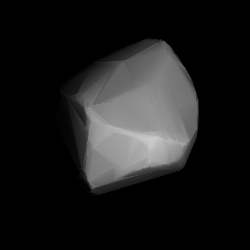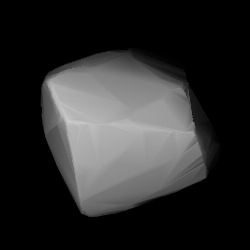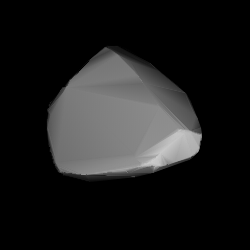Related Research Articles

199 Byblis is a medium-sized main belt asteroid.

Vincentina is a fairly large main belt asteroid.

Coelestina is a typical main belt asteroid.

Dresda is a typical Main belt asteroid. It belongs to the Koronis family of asteroids.

Phaëtusa is a small Main belt asteroid. It was discovered by Auguste Charlois on 19 August 1890 in Nice.

Margarita is a typical Main belt asteroid. It was discovered by Auguste Charlois on 16 May 1891 in Nice.

343 Ostara is a background asteroid from the inner region of the asteroid belt. It was discovered by German astronomer Max Wolf at the Heidelberg Observatory on 15 November 1892.

361 Bononia is a very large, resonant Hilda asteroid located in the outermost region of the asteroid belt. It is classified as a D-type asteroid and is probably composed of organic rich silicates, carbon and anhydrous silicates. It was discovered by Auguste Charlois on 11 March 1893, in Nice, and assigned the prov. designations A893 EF and 1893 P.

394 Arduina is an asteroid from the central regions of the asteroid belt. It was discovered by A. Borrelly on 19 November 1894 in Marseilles.

Nassovia is a minor planet orbiting the Sun. It is a member of the Koronis family of asteroids.
Emanuela is an asteroid orbiting the Sun.

621 Werdandi is a Themistian asteroid.
623 Chimaera is a minor planet, specifically an asteroid orbiting in the asteroid belt.

662 Newtonia is a minor planet, specifically an asteroid orbiting mostly in the asteroid belt.
668 Dora is an asteroid orbiting in the asteroid belt located roughly between the orbits of the planets Mars and Jupiter. The name may have been inspired by the asteroid's provisional designation 1908 DO.
818 Kapteynia is a minor planet orbiting the Sun. This asteroid is named for the Dutch astronomer Jacobus Kapteyn.

852 Wladilena is a Phocaea asteroid from the inner region of the asteroid belt. It is named after the Russian Communist leader Vladimir Lenin.

915 Cosette is an S-type asteroid belonging to the Flora family of Main Belt asteroids. Its rotation period is 4.445 hours.
966 Muschi is a main belt asteroid. It was discovered on 9 November 1921 by the German astronomer Walter Baade out of the Hamburger Sternwarte. Baade named the asteroid after his wife's nickname.
6144 Kondojiro (1994 EQ3) is an asteroid discovered on March 14, 1994 by Kin Endate and Kazuro Watanabe at the Kitami Observatory in eastern Hokkaidō, Japan. It is named after Jiro Kondo, a Japanese Egyptologist and professor of archaeology at Waseda University.
References
- ↑ Noah Webster (1884) A Practical Dictionary of the English Language
- ↑ "831 Stateira (1916 AA)". JPL Small-Body Database . NASA/Jet Propulsion Laboratory . Retrieved 4 May 2016.